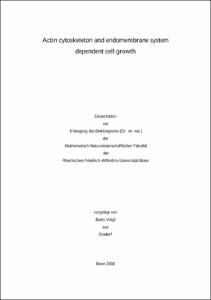Actin cytoskeleton and endomembrane system dependent cell growth

Actin cytoskeleton and endomembrane system dependent cell growth

| dc.contributor.advisor | Menzel, Diedrik | |
| dc.contributor.author | Voigt, Boris | |
| dc.date.accessioned | 2020-04-12T14:07:46Z | |
| dc.date.available | 2020-04-12T14:07:46Z | |
| dc.date.issued | 2008 | |
| dc.identifier.uri | https://hdl.handle.net/20.500.11811/3606 | |
| dc.description.abstract | In plants, membrane recycling processes are involved in every instance of cell volume changes which occur during growth, development and adaptation to the environment. The thesis work described here addresses membrane recycling on three different levels. (i) The level of the actin cytoskeleton as the major cytoskeletal structure, which supports vesicle trafficking in plant cells. (ii) The level of endosomal dynamics as the major membrane compartment that is involved in membrane recycling at the plasma membrane and (iii) at the level of macromolecular components, which are involved in vesicle fusion. 1) The actin cytoskeleton: A GFP-based actin cytoskeleton reporter construct has been designed, GFP-FABD2, on the basis of the plant fimbrin 1 sequence, which proved to be very reliable and useful as a faithful reporter of the actin cytoskeleton in transgenic A. thaliana lines. With this new fluorescent reporter, the structure and dynamic of the actin cytoskeleton is studied in greater detail in correlation with the motile behaviour of endosomal compartments. 2) Endosomal dynamics: A second new GFP-reporter was constructed by using two tandemly linked PI(3)P binding domains (double-FYVE) from a mouse endosomal protein. Since endosomal membranes contain PI(3)P in yeast, animals and plants, the strategy was to identify endosomes by the binding affinity of the FYVE domains to PI(3)P. It turned out that this strategy works well and through co-localization with endosomal markers and other fluorescent dyes and by pharmacological perturbation, the endosomal nature of the labelled membrane compartment is confirmed. The generation of stabe transgenic A. thaliana lines allows the detailed analysis of the PI(3)P containing endosomes throughout root tissues. 3) SYP121 as a component of the targeting/fusion machinery: SYP121 has previously been identified by others as a member of the syntaxin family in A. thaliana. Here, the distribution of this protein and its behaviour at membrane recycling sites is studied. On the basis of the SYP121 gene sequence, a GFP-reporter was constructed. By co-localization with endosomal markers it is shown, that SYP121 is present on the endosomal compartment and pharmacological treatments reveal, that it behaves in the same way as the double FYVE-reporter. SYP121 is present at the tip of the growing root hairs and associates with the growing cell plate during cytokinesis. Since it has been shown by others, that SYP121 is also present at the site of papilla formation in the course of fungal infection, it is suggested that this member of the t-SNARE family is of importance for a variety of vesicle fusion events, i.e., tip growth, cell plate expansion and papilla formation, and it can also be concluded that plant endosomes are involved in t-SNARE recycling in each of these cases. 4) Synaptotagmin A as a component of the targeting/fusion machinery: synaptotagmins comprise a large family of proteins, originally discovered in neuronal synapses, but afterwards found in many other types of animal tissues. Biochemically they are Ca-dependent, PIP-binding membrane proteins involved in the fusion process during exocytosis. Six closely related proteins exist in plants, termed Synaptotagmin-like proteins. Here, the expression pattern of the six members of the A. thaliana synaptotagmin gene family are investigated by promoter-GUS fusions, and the localization of their most abundant member, SytA, is studied in detail. A SytA-GFP gene fusion was constructed and transformed stably into A. thaliana as well as transiently into tobacco leaves. The SytA T-DNA mutant line shows a phenotype, dependent on high salt concentrations or moderate salt concentrations together with low Ca-concentrations. These data suggest that SytA is mainly involved in cell volume regulation in response to salt stress by mediating Ca-dependent vesicle fusion with the plasma membrane, whereas the other members are likely to be involved in development-specific regulation of cell volume changes. | en |
| dc.language.iso | eng | |
| dc.rights | In Copyright | |
| dc.rights.uri | http://rightsstatements.org/vocab/InC/1.0/ | |
| dc.subject | actin cytoskeleton | |
| dc.subject | fimbrin | |
| dc.subject | endocytosis | |
| dc.subject | syntaxin | |
| dc.subject.ddc | 570 Biowissenschaften, Biologie | |
| dc.title | Actin cytoskeleton and endomembrane system dependent cell growth | |
| dc.type | Dissertation oder Habilitation | |
| dc.publisher.name | Universitäts- und Landesbibliothek Bonn | |
| dc.publisher.location | Bonn | |
| dc.rights.accessRights | openAccess | |
| dc.identifier.urn | https://nbn-resolving.org/urn:nbn:de:hbz:5N-13998 | |
| ulbbn.pubtype | Erstveröffentlichung | |
| ulbbnediss.affiliation.name | Rheinische Friedrich-Wilhelms-Universität Bonn | |
| ulbbnediss.affiliation.location | Bonn | |
| ulbbnediss.thesis.level | Dissertation | |
| ulbbnediss.dissID | 1399 | |
| ulbbnediss.date.accepted | 25.04.2008 | |
| ulbbnediss.fakultaet | Mathematisch-Naturwissenschaftliche Fakultät | |
| dc.contributor.coReferee | Baluška, František |
Files in this item
This item appears in the following Collection(s)
-
E-Dissertationen (4337)




